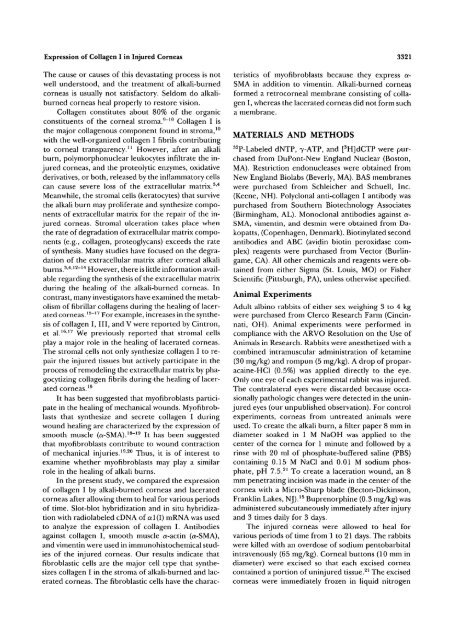Expression of Collagen I, Smooth Muscle a-Actin, and Vimentin ...
Expression of Collagen I, Smooth Muscle a-Actin, and Vimentin ...
Expression of Collagen I, Smooth Muscle a-Actin, and Vimentin ...
You also want an ePaper? Increase the reach of your titles
YUMPU automatically turns print PDFs into web optimized ePapers that Google loves.
<strong>Expression</strong> <strong>of</strong> <strong>Collagen</strong> I in Injured Corneas 3321<br />
The cause or causes <strong>of</strong> this devastating process is not<br />
well understood, <strong>and</strong> the treatment <strong>of</strong> alkali-burned<br />
corneas is usually not satisfactory. Seldom do alkaliburned<br />
corneas heal properly to restore vision.<br />
<strong>Collagen</strong> constitutes about 80% <strong>of</strong> the organic<br />
constituents <strong>of</strong> the corneal stroma. 9 " 10 <strong>Collagen</strong> I is<br />
the major collagenous component found in stroma, 10<br />
with the well-organized collagen I fibrils contributing<br />
to corneal transparency. 11 However, after an alkali<br />
burn, polymorphonuclear leukocytes infiltrate the injured<br />
corneas, <strong>and</strong> the proteolytic enzymes, oxidative<br />
derivatives, or both, released by the inflammatory cells<br />
can cause severe loss <strong>of</strong> the extracellular matrix. 34<br />
Meanwhile, the stromal cells (keratocytes) that survive<br />
the alkali burn may proliferate <strong>and</strong> synthesize components<br />
<strong>of</strong> extracellular matrix for the repair <strong>of</strong> the injured<br />
corneas. Stromal ulceration takes place when<br />
the rate <strong>of</strong> degradation <strong>of</strong> extracellular matrix components<br />
(e.g., collagen, proteoglycans) exceeds the rate<br />
<strong>of</strong> synthesis. Many studies have focused on the degradation<br />
<strong>of</strong> the extracellular matrix after corneal alkali<br />
burns. 3412 " 14 However, there is little information available<br />
regarding the synthesis <strong>of</strong> the extracellular matrix<br />
during the healing <strong>of</strong> the alkali-burned corneas. In<br />
contrast, many investigators have examined the metabolism<br />
<strong>of</strong> fibrillar collagens during the healing <strong>of</strong> lacerated<br />
corneas. 15 " 17 For example, increases in the synthesis<br />
<strong>of</strong> collagen I, III, <strong>and</strong> V were reported by Cintron,<br />
et al. 1617 We previously reported that stromal cells<br />
play a major role in the healing <strong>of</strong> lacerated corneas.<br />
The stromal cells not only synthesize collagen I to repair<br />
the injured tissues but actively participate in the<br />
process <strong>of</strong> remodeling the extracellular matrix by phagocytizing<br />
collagen fibrils during'the healing <strong>of</strong> lacerated<br />
corneas. 15<br />
It has been suggested that my<strong>of</strong>ibroblasts participate<br />
in the healing <strong>of</strong> mechanical wounds. My<strong>of</strong>ibroblasts<br />
that synthesize <strong>and</strong> secrete collagen I during<br />
wound healing are characterized by the expression <strong>of</strong><br />
smooth muscle (a-SMA). 18 " 19 It has been suggested<br />
that my<strong>of</strong>ibroblasts contribute to wound contraction<br />
<strong>of</strong> mechanical injuries. 1920 Thus, it is <strong>of</strong> interest to<br />
examine whether my<strong>of</strong>ibroblasts may play a similar<br />
role in the healing <strong>of</strong> alkali burns.<br />
In the present study, we compared the expression<br />
<strong>of</strong> collagen I by alkali-burned corneas <strong>and</strong> lacerated<br />
corneas after allowing them to heal for various periods<br />
<strong>of</strong> time. Slot-blot hybridization <strong>and</strong> in situ hybridization<br />
with radiolabeled cDNA <strong>of</strong> al (I) mRNA was used<br />
to analyze the expression <strong>of</strong> collagen I. Antibodies<br />
against collagen I, smooth muscle a-actin (a-SMA),<br />
<strong>and</strong> vimentin were used in immunohistochemical studies<br />
<strong>of</strong> the injured corneas. Our results indicate that<br />
fibroblastic cells are the major cell type that synthesizes<br />
collagen I in the stroma <strong>of</strong> alkali-burned <strong>and</strong> lacerated<br />
corneas. The fibroblastic cells have the characteristics<br />
<strong>of</strong> my<strong>of</strong>ibroblasts because they express a-<br />
SMA in addition to vimentin. Alkali-burned corneas,<br />
formed a retrocorneal membrane consisting <strong>of</strong> collagen<br />
I, whereas the lacerated corneas did not form such<br />
a membrane.<br />
MATERIALS AND METHODS<br />
32 P-Labeled dNTP, 7-ATP, <strong>and</strong> [ 3 H]dCTP were purchased<br />
from DuPont-New Engl<strong>and</strong> Nuclear (Boston,<br />
MA). Restriction endonucleases were obtained from<br />
New Engl<strong>and</strong> Biolabs (Beverly, MA). BAS membranes<br />
were purchased from Schleicher <strong>and</strong> Schuell, Inc.<br />
(Keene, NH). Polyclonal anti-collagen I antibody was<br />
purchased from Southern Biotechnology Associates<br />
(Birmingham, AL). Monoclonal antibodies against a-<br />
SMA, vimentin, <strong>and</strong> desmin were obtained from Dakopatts,<br />
(Copenhagen, Denmark). Biotinylated second<br />
antibodies <strong>and</strong> ABC (avidin biotin peroxidase complex)<br />
reagents were purchased from Vector (Burlingame,<br />
CA). All other chemicals <strong>and</strong> reagents were obtained<br />
from either Sigma (St. Louis, MO) or Fisher<br />
Scientific (Pittsburgh, PA), unless otherwise specified.<br />
Animal Experiments<br />
Adult albino rabbits <strong>of</strong> either sex weighing 3 to 4 kg<br />
were purchased from Clerco Research Farm (Cincinnati,<br />
OH). Animal experiments were performed in<br />
compliance with the ARVO Resolution on the Use <strong>of</strong><br />
Animals in Research. Rabbits were anesthetized with a<br />
combined intramuscular administration <strong>of</strong> ketamine<br />
(30 mg/kg) <strong>and</strong> rompun (5 mg/kg). A drop <strong>of</strong> proparacaine-HCl<br />
(0.5%) was applied directly to the eye.<br />
Only one eye <strong>of</strong> each experimental rabbit was injured.<br />
The contralateral eyes were discarded because occasionally<br />
pathologic changes were detected in the uninjured<br />
eyes (our unpublished observation). For control<br />
experiments, corneas from untreated animals were<br />
used. To create the alkali burn, a filter paper 8 mm in<br />
diameter soaked in 1 M NaOH was applied to the<br />
center <strong>of</strong> the cornea for 1 minute <strong>and</strong> followed by a<br />
rinse with 20 ml <strong>of</strong> phosphate-buffered saline (PBS)<br />
containing 0.15 M NaCl <strong>and</strong> 0.01 M sodium phosphate,<br />
pH 7.5. 21 To create a laceration wound, an 8<br />
mm penetrating incision was made in the center <strong>of</strong> the<br />
cornea with a Micro-Sharp blade (Becton-Dickinson,<br />
Franklin Lakes, NJ). 15 Buprenorphine (0.3 mg/kg) was<br />
administered subcutaneously immediately after injury<br />
<strong>and</strong> 3 times daily for 3 days.<br />
The injured corneas were allowed to heal for<br />
various periods <strong>of</strong> time from 1 to 21 days. The rabbits<br />
were killed with an overdose <strong>of</strong> sodium pentobarbital<br />
intravenously (65 mg/kg). Corneal buttons (10 mm in<br />
diameter) were excised so that each excised cornea<br />
contained a portion <strong>of</strong> uninjured tissue. 21 The excised<br />
corneas were immediately frozen in liquid nitrogen
















